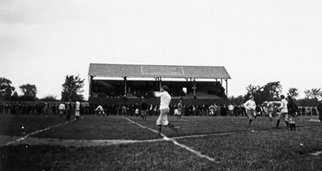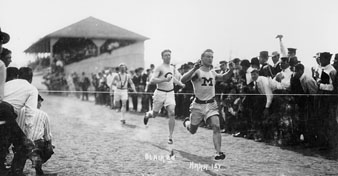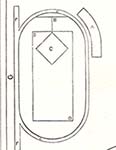
Regents Field, 1893-1905
Student agitation for better recreation facilities and the administration's concerns over holding football games off campus at the Ann Arbor Fairgrounds led to the acquisition of Michigan's first permanent home field.
In October 1890 the Board of Regents authorized expenditure of $3,000 to acquire land for athletic uses. A ten acre parcel along South State street, approximately where Schembechler Hall now stands, was purchased in 1891. At their May 1891 meeting, the Regents appropriated $4,500 "for the purpose of fitting up the athletic field." Under the direction of the University Buildings and Grounds Committee the north half of the parcel was leveled and a quarter mile cinder track laid out. An additional $400 was appropriated for improvement of the field in October of 1891. The original design of the Athletic Field, printed in the May 5, 1891 Michigan Daily, shows the grandstand at the east endzone and baseball infield. It was modified to put the grandstand on north sideline.
As the field neared completion, questions arose over who should manage it. In May 1892 the Regents unanimously approved a resolution introduced by Regent Whitman of the Committee on Building and Grounds to place the students in charge.
Resolved; that the directors of the University Athletic Association shall have control of the Athletic field for the remainder of the college year, under the general direction of the Advisory Board.;
Provided; that they keep the grounds in good repair and keep them properly sprinkled during the summer season, and, Provided, That the grounds shall not be rented or let to any organization or person not connected with the University; it being understood also the Association shall be entitled to the gate receipts.
At the same meeting the Regents voted to put in a water pipe from the street to the grandstand. The students apparently did a satisfactory job of watering the field for at the their September meeting the Regents extended the Athletic Associations's control of the field "until otherwise ordered."
Originally called simply "the Athletic Field," the grounds were laid out to accommodate both a baseball diamond and a gridiron. A small covered grandstand seating 400 was built along the north edge of the field. The new facility was ready for the start of the 1892 season. On October 8 Michigan played on a permanent home field for the first time, defeating the Michigan Athletic Assoation team 74-0.

Original Regents Field Grandstand
While a student at UM from 1894 to 1895, David LeFavour photographed many campus scenes, including football games. This photo shows game action at Regents Field with the original grandstand. It is uncertain if this photo depicts a varsity game or an inter-class contest.
The Athletic Association officially changed the name of the field to Regents Field in 1894, by which name it would be known until 1902. In June of 1894 the Association petitioned the Board of Regents on the question of "water closets" for the Athletic Field. The Regents simply tabled the request. It is not clear when facilities were finally installed.

The new grandstand in 1896
The original grandstand burned in 1895. In May of 1896 the Regents authorized construction of a new grandstand at a cost of $1,370. The 800 seat, covered stand stood on the site of the original grandstand and would remain in use through 1905.
The demand for tickets soon required construction of additional bleacher seating. Following the example of the large Eastern universities, high, open bleachers seating about 6,000 were built adjoining the covered grandstand. As the gridiron was laid out on the baseball field, the bleachers were designed to be movable and were placed and removed each season. According to Baird, the Athletic Association also had "one thousand circus seats and materials for sloping platforms which will permit 8,000 more people to view a football game." Bleachers were later constructed along the south side of the field and the end zones, bringing capacity to over 15,000. A number of other improvements were made over the years. The south half of the original ten acres was leveled and sodded, a caretakers house was moved onto the site and a press box was constructed on the roof of the grandstand. Baird estimated that prior to 1900 the Athletic Association had spent over $12,000 on improvements to Regents Field.
In 1902, Detroit businessman Dexter Ferry donated the land immediately north of Regents Field to the university and the entire complex was renamed Ferry Field. The Athletic Association made several small additional purchases to extend the Ferry Field parcel to the railroad tracks to the west, bringing the total acreage to 38.
 In the 1890s a three dollar membership in the Athletic Association gained students admission to all athletic events. By 1904 a general admission ticket for the "big games" could cost as much as $3.00.
In the 1890s a three dollar membership in the Athletic Association gained students admission to all athletic events. By 1904 a general admission ticket for the "big games" could cost as much as $3.00.
The earliest attendance figures available are for the 1894 Oberlin game, a 14-6 Michigan victory witnessed by 2,200 spectators. The largest crowd ever at Regents/Ferry Field was for the second to last game at the old stadium. By one account, 17,000 fans watched the Wolverines defeat Wisconsin in the 1905 homecoming game.

1905 Wisconsin game, last game at Regents Field, attendance of 17,000
Regents Field was home field for several of Michigan's greatest teams and individual stars. Center William Cunningham was named Michigan's first All-American in 1898. Neil Snow, end and fullback, was an All-American in 1901, four time All-Western, and star of the first Rose Bowl, also excelled on the Regents Field track and baseball diamond, earning 10 varsity letters. The incomparable halfback Willie Heston, twice an All-American, scored many of his school record 72 touchdowns at Regents Field.
Michigan compiled an overall record of 87 wins 2 losses and 3 ties at Regents/Ferry Field between 1893 and 190. Fielding Yost's great "point-a-minute" teams of 1901-190 went 44-0 at Regents Field, outscoring their opponents 2821-42. Possibly the greatest victory at Regents Field came in the 1904 Chicago game. Michigan beat the previously undefeated team of Amos Alonzo Stagg 22-12 to win the Western Conference title and be proclaimed national champion. Portions of that game and several panoramic shots of Ferry Field were captured on film by the Edison Company in one of the earliest successful attempts to film football game action.

Kickoff for the 1904 Chicago game
As football trainer for most of the Regents Field era, Keene Fitzpatrick was instrumental in the team's success, and as track coach he also produced many champions on Regents Field. Among them were Olympic gold medalists Charles Dvorak (pole vault 1904), Archie Hahn (60, 100 and 200 meters 1904, 100 meters 1906), Ralph Rose (shot put 1904 and 1908, combined shot put 1912) and Fred Schule (hurdles 1904).

Archie
Hahn takes first in 220 yard race at Ferry Field, 1903
Soon after the donation of land by Dexter Ferry in 1902 plans were being made for a new stadium. The tremendous fan interest generated by the success of Fielding Yost's teams of 1901-1905 set the stage for the next era in Michigan home fields.
Image Credits:
- Regents Field 1894 - BHL, David Lefavour Papers.
- The new grandstand, 1896 - Michiganensian, 1899
- 1903 Wisconsin Ticket - BHL, Ath Dept. Scrapbook
- Ferry Field, 190 Wisconsin game - BHL, Ath. Dept., Box 3 out.
- Ferry Field, Kickoff of 1904 Chicago game - BHL, Ath. Dept. Box 3 out.
- Archie Hahn at Ferry Field - BHL, Ath. Dept. Box 41, 1901-190
top | previous | next
| Stadium Home Page | Ath. Dept. MGOBLUE |
Ath. History | Bentley Library


